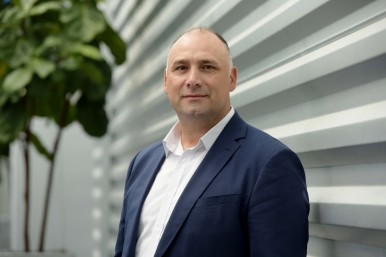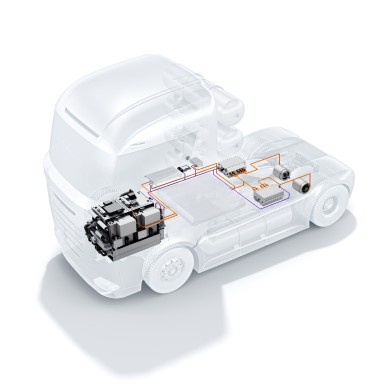- Launched at Sensors Expo, ultra-low power, high precision 6-axis IMU provides industry-leading footprint - Enables always-on applications for wearable devices and supports precise 9-axis sensor data fusion computation - With four billion MEMS sensors supplied, every second smart phone worldwide uses Bosch sensors Bosch Sensortecs new BMI160 Inertial Measurement Unit (IMU) integrates a state-of-the-art 16 bit 3-axis, low-g accelerometer and an ultra-low power 3-axis gyroscope into a single package. It has been designed specifically for high precision, always-on 6-axis and 9-axis applications in smart phones, tablets, wearable devices, remote controls, game controllers, head-mounted devices and toys. The BMI160 is available in a 14-pin 2.5 × 3.0 × 0.8 mm3 LGA package. When the accelerometer and gyroscope are in full operation mode, the typical current consumption is 950µA, best in class by a factor of two. Applications such as immersive gaming, augmented reality and the emerging 3D indoor scanning applications must deliver precise, real-time user experiences. The BMI160 achieves this by synchronizing the inertial accelerometer and gyroscope sensor data precisely with external geomagnetic sensor data, and is ideally suited for applications requiring exact, low latency low power 9-axis sensor data fusion. “Current battery limitations in devices such as smart watches, augmented reality glasses and wearable devices are restricting the adoption of more sophisticated applications which need to be continuously powered,” says Jeanne Forget, Marketing Director of Bosch Sensortec. “With its industry-leading current consumption, the BMI160 makes a significant contribution to overcoming this hurdle, and will help usher in a new era of always-on applications.” Precise sensor data fusion Additional sensors from the Bosch Sensortec family, such as geomagnetic (BMM series) or pressure sensors (BMP series), can be connected via a secondary I2C interface. In this configuration, the BMI160 controls data acquisition of the external sensor with all sensor data being stored in the built-in FIFO. With the secondary interface configured as high speed SPI interface and connected to camera module, BMI160 also supports optical image stabilization (OIS). Smart power management and built-in FIFO The built-in power management unit (PMU) can be configured to further lower power consumption by automatically sending the gyroscope temporarily into fast start-up mode, then wake-up using the any-motion interrupt of the accelerometer. When connected to a geomagnetic sensor, the BMI160 can trigger a read-out of the magnetometer sensor data without host processor intervention. Longer host controller sleep cycles reduce power consumption at the system level. The integrated FIFO supports low power applications and prevents data loss in non-real-time systems. The FIFO architecture allows dynamic reallocation of FIFO space for accelerometer, gyroscope and external sensors respectively. The BMI160 features an on-chip interrupt engine enabling low-power motion-based gesture recognition and context awareness. Interrupts issued in a power efficient manner include: any- or no-motion detection, tap or double tap sensing, orientation detection, free-fall or shock events. Android 4.4 (KitKat) and Windows 8.1 compliance The BMI160 fulfils the requirements of most standard operating systems and is fully Android 4.4 (KitKat) and Windows 8.1 compliant. Significant motion and step detector interrupts consume less than 200µA each. The BMI160 is intended for high-volume consumer electronics manufacturers. Samples of the BMI160 are available now to key development customers. The technology among others will be introduced in the Bosch Sensortec / Akustica booth (Booth 302) at the Sensors Expo & Conference, the leading industry event in North America, held June 24–26, 2014 at the Donald E. Stephens Convention Center, Rosemont, IL. Global leader in sensor technology Bosch provides sensors for a range of uses in the automotive and consumer electronics industries. MEMS sensors measure pressure, acceleration, rotary motion, mass flow, and the earths magnetic field, and act as the sensory organs for cars or smart phones. Bosch has been producing these sensors for vehicles since 1995. A yaw-rate sensor that records the rotary moments around its vertical axis is at the heart of electronic stability control (ESC), for example, and today most vehicles are home to up to 50 MEMS sensors. Bosch has been at the forefront of MEMS technology since it first emerged, and is the worlds leading supplier in this extremely dynamic market, as the experts at IHS Technology and Yole Développement have confirmed. Since the start of production in 1995, Bosch has manufactured well in excess of four billion MEMS sensors. In 2013, around one billion sensors emerged from its state-of-the-art wafer fab in Reutlingen – or three million each day. “Bosch is the only supplier that manufactures sensor types for so many different applications. Overall, Bosch holds more than 1,000 patents and patent applications related to MEMS technology to ensure we stay on top of our innovative capacity,” says Klaus Meder, president of the Bosch Automotive Electronics division. Thanks to Bosch Sensortec acceleration sensors, a smart phone or tablet knows how it is being held and adjusts the image accordingly. Early this year, Bosch Sensortec unveiled the BME280 integrated unit, which combines sensors for pressure, humidity, and temperature in a single housing. The new unit was specially developed for applications related to environmental monitoring, indoor navigation, smart homes, personalized weather stations, and sports and fitness. Within a second, it can determine humidity – the fastest response time in the industry - and offers remarkably precise measurement of ambient temperature and impressively low energy consumption. Production is about to begin on the first sensor for measuring physical variables, such as acceleration, rotary motion, and the earths magnetic field, and it will also include a micro-controller for evaluating readings. MEMS microphones made by Akustica, a wholly-owned subsidiary of the Bosch Group, detect sounds and speech. Now every second smart phone worldwide uses Bosch sensors. More information is available online: - Sensors for increased safety in vehicles: new generation of Bosch inertial sensors - Simplifying development of airbag systems: new Bosch acceleration sensors - Bosch is top MEMS maker in 2013 - Bosch sensors for automobile electronics - Bosch sensors for consumer electronics - MEMS microphones - Bosch sets up company for internet of things and services Sensors – how technology maps the world around it - MEMS: the stars of the sensor world - Car-to-X: the future is about connectivity - Greater safety with peripheral sensors - Internet-enabled MEMS sensors About Bosch Bosch Sensortec GmbH is a fully owned subsidiary of Robert Bosch GmbH, dedicated to the consumer electronics world offering a complete portfolio of micro-electro mechanical systems (MEMS) sensors and solutions that enable mobile devices to feel and sense the world around them. Bosch Sensortec develops and markets a wide portfolio of MEMS sensors and solutions for smart phones, tablets, wearable devices and IoTS (Internet of Things & Services) applications. The product portfolio includes 3-axis acceleration, gyroscope and geomagnetic sensors, integrated 6- and 9-axis as well as environmental sensors and a comprehensive software portfolio. Since its foundation in 2005 Bosch Sensortec emerged as the technology leader in the addressed markets. The Bosch Group has been the global market leader for MEMS sensors since 1998 and has to date sold more than 3 billion MEMS sensors. For more information, go to www.bosch-sensortec.com Akustica is a wholly owned subsidiary of the Bosch Group and a top supplier of silicon microphone products that are improving voice-input quality in a host of voice-enabled applications, from mobile phones, laptops, tablets, to small wearable accessories like headsets. The company offers worldwide customer support services, from design-in services to post-production quality assurance. Akustica is a global organization with corporate headquarters in Pittsburgh, PA, regional offices in Taiwan and Shanghai, and a worldwide team of distributors. For more information about Akustica, go to: www.akustica.com. The Bosch Group is a leading global supplier of technology and services. In 2013, its roughly 281,000 associates generated sales of 46.1 billion euros. (NB: Due to a change in accounting policies, the 2013 figures can only be compared to a limited extent with the 2012 figures). Its operations are divided into four business sectors: Automotive Technology, Industrial Technology, Consumer Goods, and Energy and Building Technology. The Bosch Group comprises Robert Bosch GmbH and its roughly 360 subsidiaries and regional companies in some 50 countries. If its sales and service partners are included, then Bosch is represented in roughly 150 countries. This worldwide development, manufacturing, and sales network is the foundation for further growth. In 2013, the Bosch Group invested some 4.5 billion euros in research and development and applied for some 5,000 patents. This is an average of 20 patents per day. The Bosch Groups products and services are designed to fascinate, and to improve the quality of life by providing solutions which are both innovative and beneficial. In this way, the company offers technology worldwide that is “Invented for life.” Additional information can be accessed at www.bosch.com, www.bosch-press.com and http://twitter.com/BoschPresse
Having established a regional presence in 1906 in North America, the Bosch Group employs 34,700 associates in more than 100 locations, as of December 31, 2020. According to preliminary figures, Bosch generated consolidated sales of $13.1 billion in the U.S., Canada and Mexico. For more information, visit www.bosch.us, www.bosch.ca and www.bosch.com.mx.
The Bosch Group is a leading global supplier of technology and services. It employs roughly 394,500 associates worldwide (as of December 31, 2020). According to preliminary figures, the company generated sales of $87.1 billion in 2020. Its operations are divided into four business sectors: Mobility Solutions, Industrial Technology, Consumer Goods, and Energy and Building Technology. As a leading IoT provider, Bosch offers innovative solutions for smart homes, Industry 4.0, and connected mobility. Bosch is pursuing a vision of mobility that is sustainable, safe, and exciting. It uses its expertise in sensor technology, software, and services, as well as its own IoT cloud, to offer its customers connected, cross-domain solutions from a single source. The Bosch Group’s strategic objective is to facilitate connected living with products and solutions that either contain artificial intelligence (AI) or have been developed or manufactured with its help. Bosch improves quality of life worldwide with products and services that are innovative and spark enthusiasm. In short, Bosch creates technology that is “Invented for life.” The Bosch Group comprises Robert Bosch GmbH and its roughly 440 subsidiary and regional companies in 60 countries. Including sales and service partners, Bosch’s global manufacturing, engineering, and sales network covers nearly every country in the world. The basis for the company’s future growth is its innovative strength. At 126 locations across the globe, Bosch employs some 73,000 associates in research and development, as well as roughly 30,000 software engineers.
Additional information is available online at www.bosch.us, www.iot.bosch.com, https://us.bosch-press.com, https://twitter.com/BoschPress
Exchange rate: 1 EUR = 1.2171





